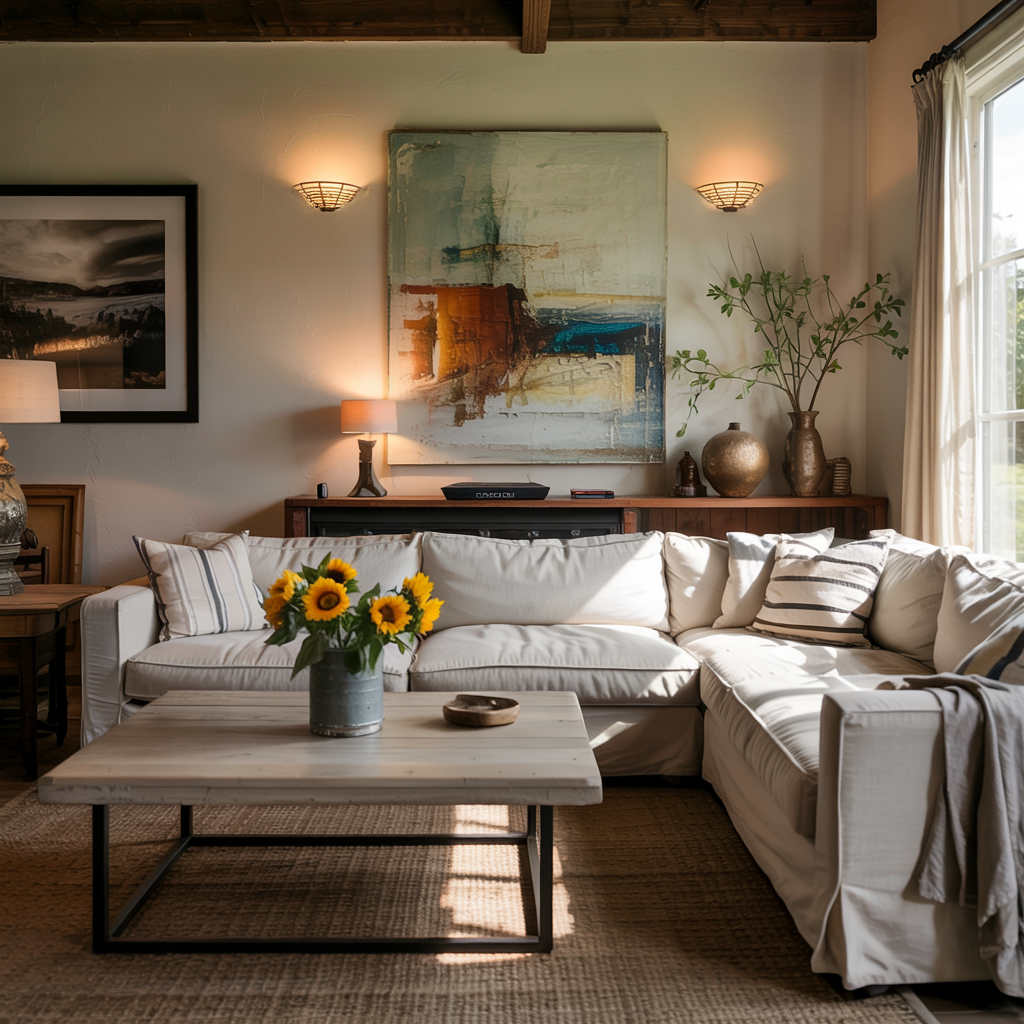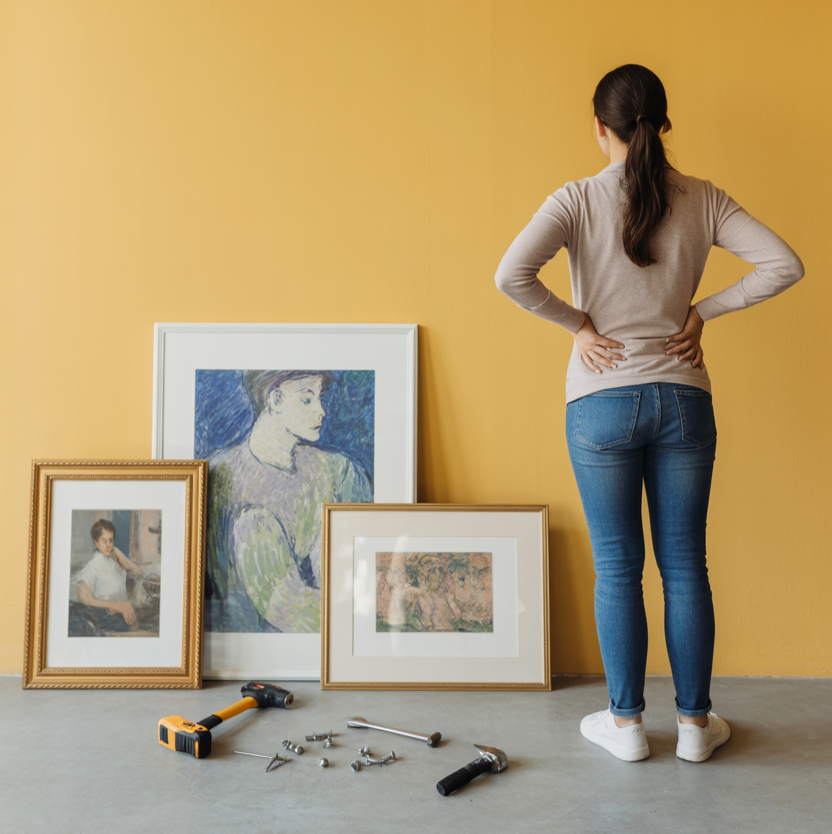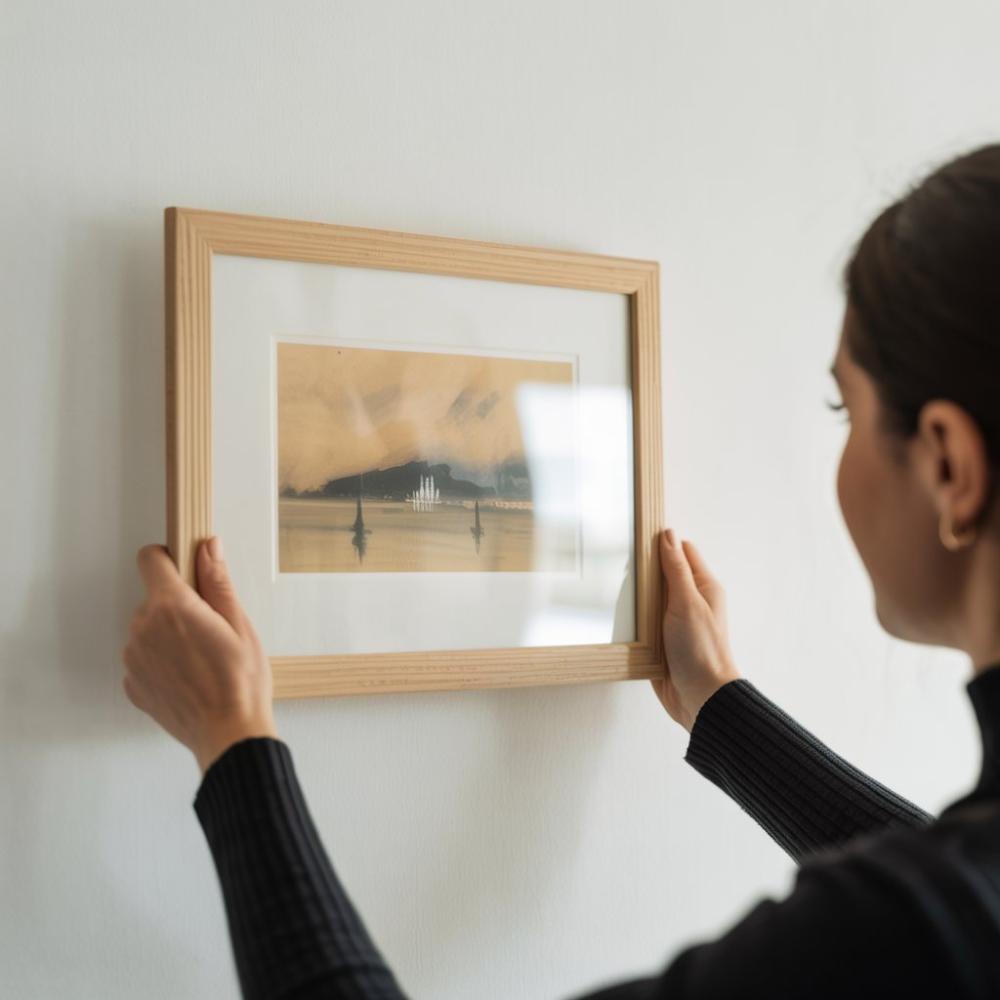Part 1 in the 3-part Beginner’s Guide to Wall Art series.
Part 1: Beginner’s Guide to Choosing Wall Art
Part 2: Beginner’s Guide to Buying Wall Art
Part 3: Beginner’s Guide to Hanging Wall Art
Struggling with Blank Walls? You’re Not Alone
If you’ve been living with blank walls because decorating them feels overwhelming, you’re not alone. Many people put off adding wall art, worried about making the wrong choices or spending money on something they might regret. The fear of “getting it wrong” can hold you back from turning your space into one you truly love.
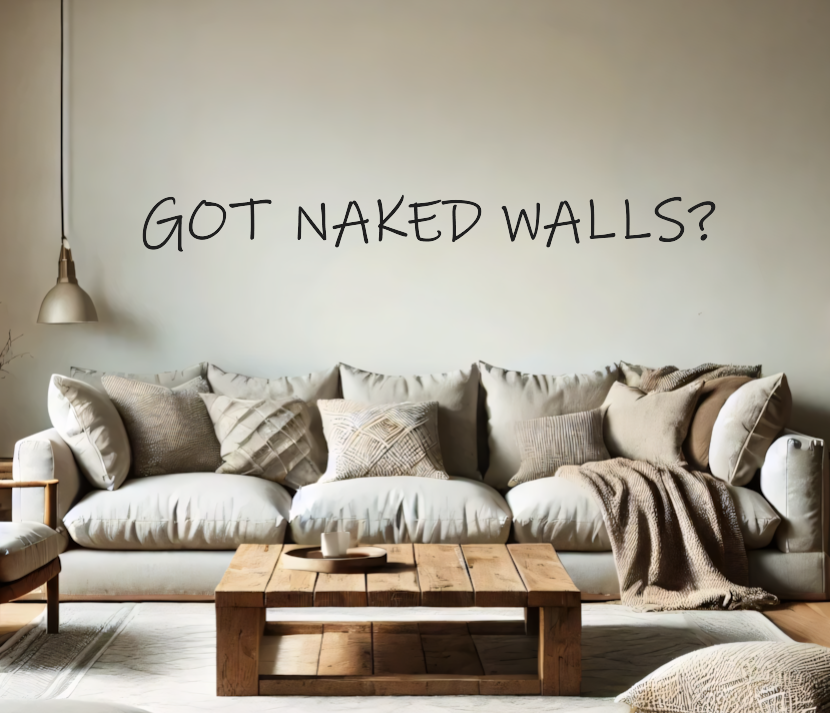
A friend of mine recently renovated her home. The new paint colors, furniture, and flooring were stunning. But the walls? Completely bare. When I asked why, she admitted she was afraid of damaging her freshly painted walls and she said she had no idea how to pick the “right” wall art. Sound familiar?
These are common fears, but here’s the good news: Your walls are the perfect opportunity to bring your personality into your home. Thoughtful wall art transforms a house into a haven, providing inspiration, comfort, and individuality. And you don’t have to be an expert or spend a fortune to get started.
Not Scary, Not Expensive!
Decorating your walls doesn’t have to be intimidating (or pricey). Whether you’re looking to enhance your style, stick to a budget, or create a cozy space that feels like you, there’s a solution for every concern.
Ready to make those blank walls a thing of the past? Let’s get to it!
Step 1: Explore Different Types of Wall Art

Wall Art Is More Than Paintings
You might be wondering, “What exactly does the term ‘wall art’ mean?” Great question!
I intentionally use the term “wall art” rather than “artwork” because it encompasses so much more than just paintings. Sure, framed pictures, prints, and canvases are all wall art. But there are countless other items you can hang to create a space that feels uniquely yours.
By thinking beyond traditional artwork, you open the door to endless possibilities—and maybe even pieces you already own!
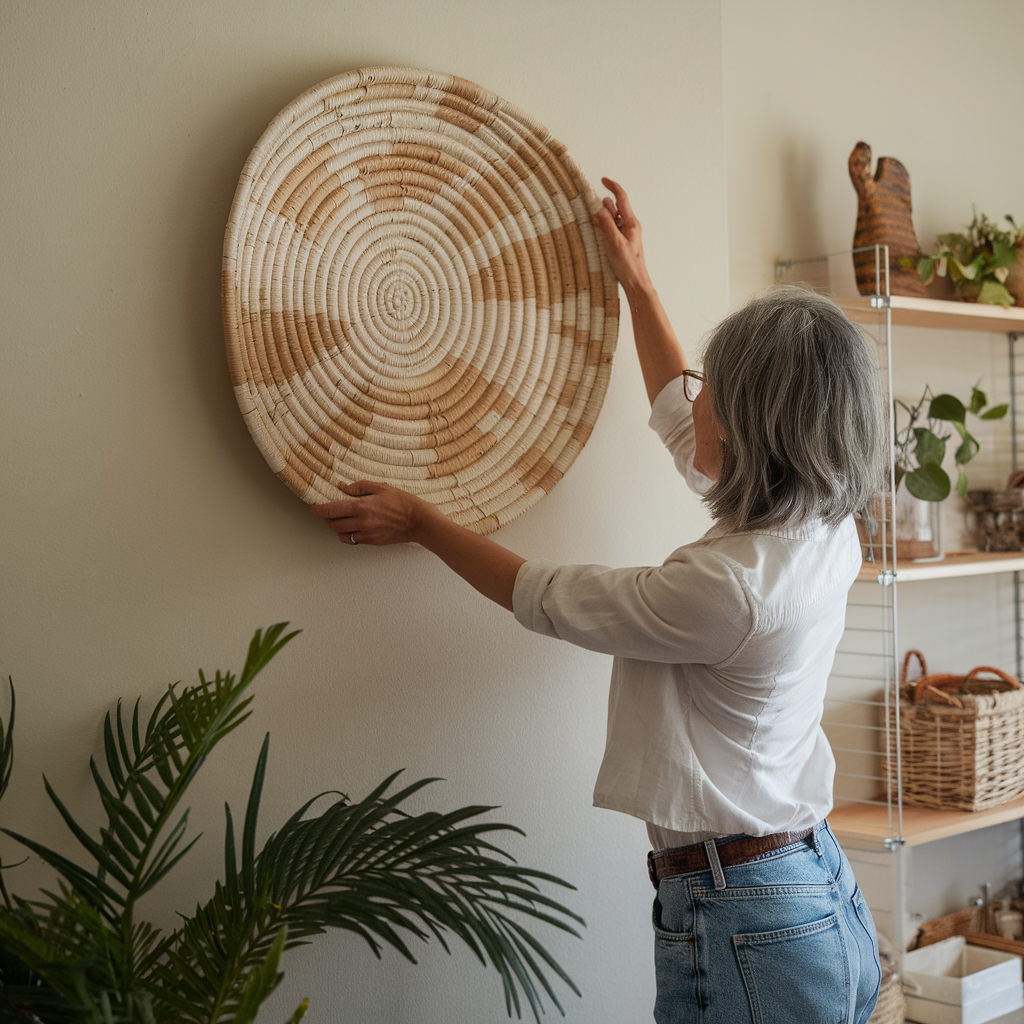
What Can You Hang on Your Walls? (And my personal list for inspiration)
When I wrote this post, I took inventory of my own home. I was surprised by how much variety I’ve collected on my walls over the years! I’m sharing my personal inventory to show you that almost anything can be wall art. You’re only limited by your imagination.
What Can Be Wall Art? Here’s What I Have On My Walls:
- Original artwork (including a painting by a family member, a sketch by an artist friend, and a piece I painted myself)
- A framed silkscreen painting, handed down as an heirloom
- Family photos, matted and framed
- Framed (mass-produced) wall art from retail stores and online
- Children’s artwork (a canvas drawing from my nephew)
- Printed and framed digital images (and other DIY “art”)
- Painted tiles
- Decorative plates
- Small paintings on wood
- Metal décor (a compass rose and a metal plaque)
- Two (dollar store) mirrors (I painted the frames)
- Needlepoint pieces (made by my niece), framed
- Framed maps
- A family member’s special award certificate, matted and framed
- Sports memorabilia (a mounted baseball bat and a framed ticket from opening day)
- Clocks
- Wreath
- A mounted plaster cast of a beloved pet’s pawprint
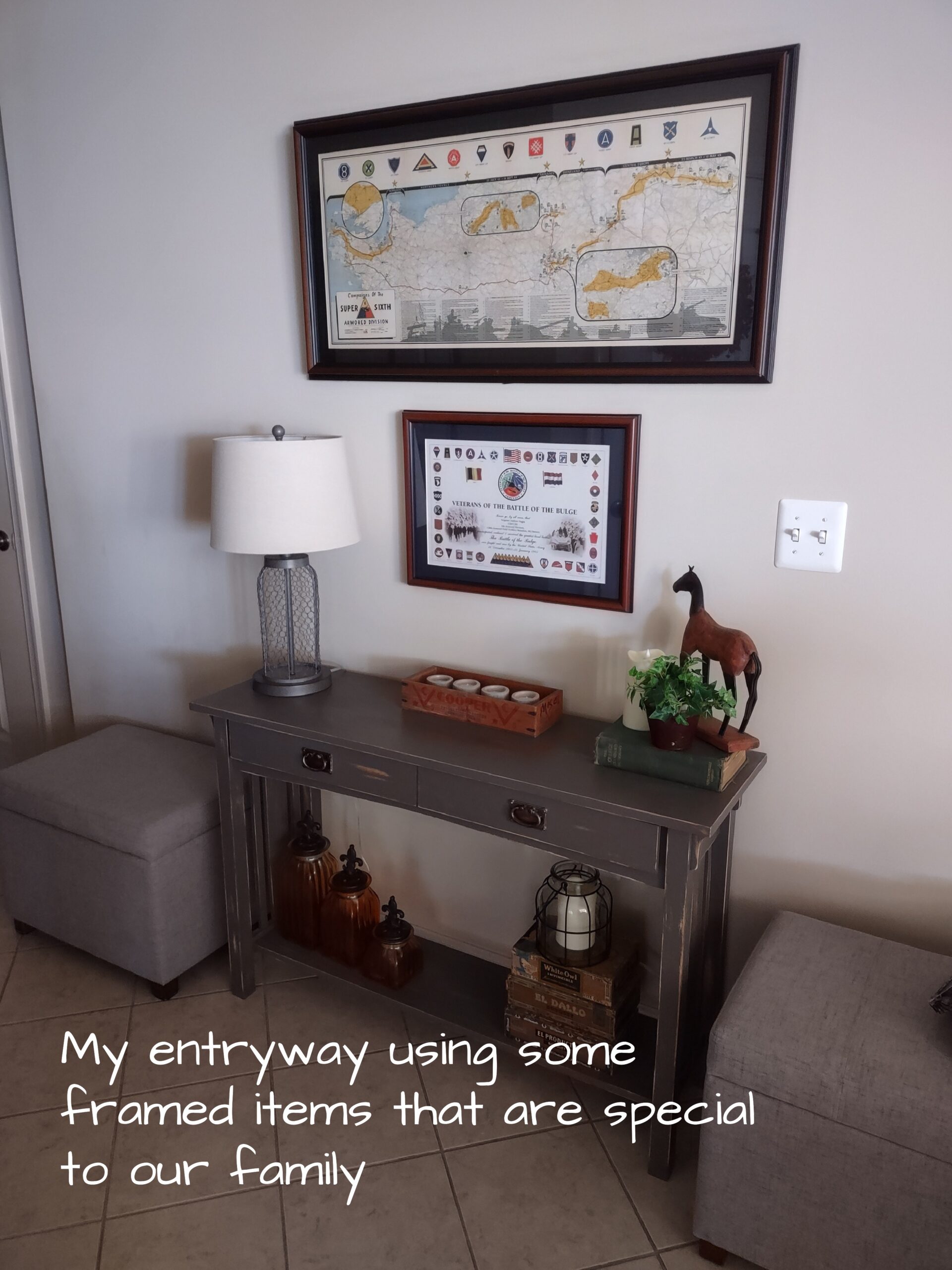
Other Wall Art Ideas
- Limited-edition prints
- Framed posters (from vintage travel ads to modern designs)
- Tapestries
- Wreaths
- Rugs
- Baskets (grouped in arrangements)
- Macramé or fiber art
- Wall-mounted plants (real or faux)
- Anything you love!
Step 2: Assess Your Space—Where Should You Hang Wall Art?

How to Decide Which Walls Need Wall Art
It’s simple: take a step back and visually assess your space. Adding wall art can create balance, focus, and visual interest. But not every wall needs something!
Ask yourself:
- Does the area feel bare or out of balance?
- Does the wall seem to lack personality?
- What is the function of the wall or space?
- Is the wall a focal point?
- Would the wall benefit from something to break up a large, empty space?
- Are there less obvious walls you may be overlooking?
Look Beyond the Obvious
Sure, the blank wall above your sofa is an easy spot for art. But have you considered:
- Hallways
- Stairwells
- Walls between windows
- Entryways
- Bathrooms
- Even behind the stove!
Take a fresh look at your walls, especially areas you might typically overlook.
For example, I added wall art to a narrow strip of wall between two windows in one of my bedrooms—and it completely transformed the space.
Be sure to check out the Beginner’s Guide to Handing Wall Art in Challenging Places !
Step 3: Choose the Right Size Wall Art
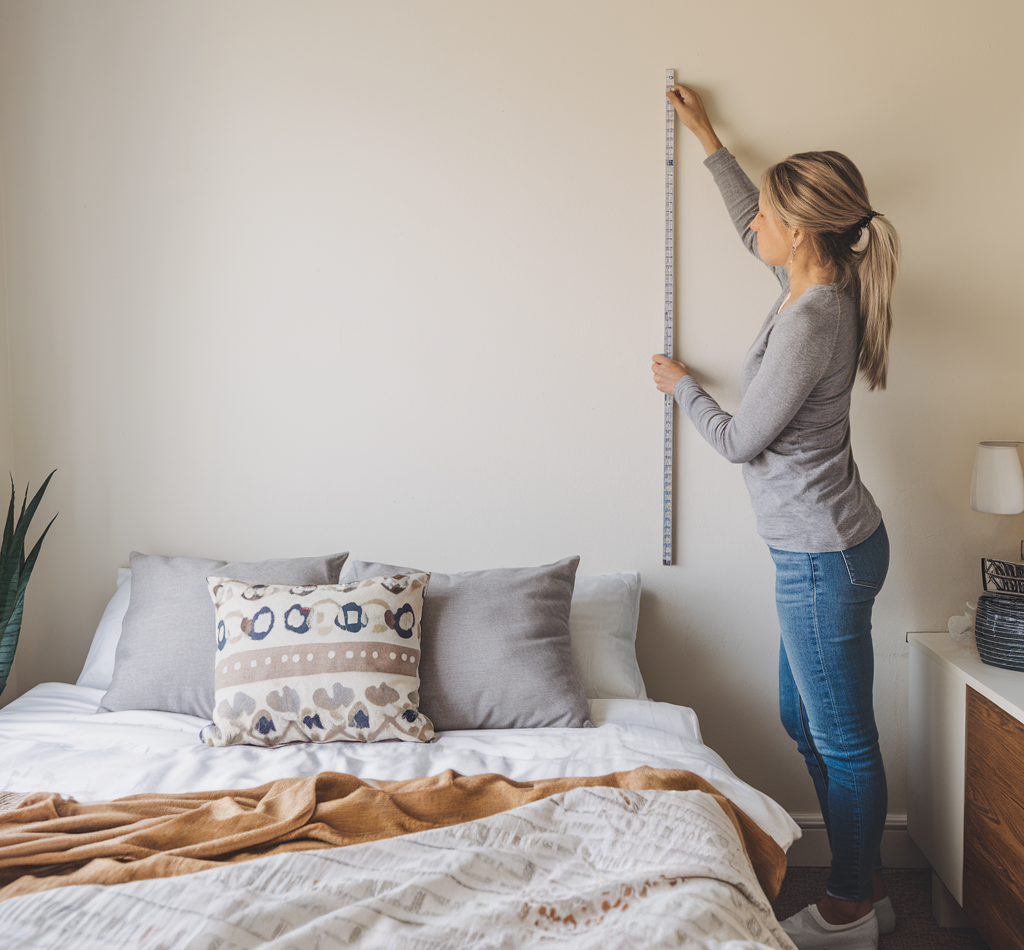
How to Pick the Right Size Wall Art for Your Space
When choosing the wall art for your space, paying attention to scale is really important. A very small picture or piece of artwork is going to look lost on a wall by itself over a large sofa for example. And a picture too large for your space will overwhelm your room.
To determine the size of your wall art, first decide if you will: (1) hang a single piece, (2) hang a group of pieces, or (3) create a gallery wall look. Each option offers a unique aesthetic and impact, so the choice ultimately depends on your personal taste, style, and the space you’re decorating. Here’s how to decide which approach works best for you, along with size tips to guide your selection:
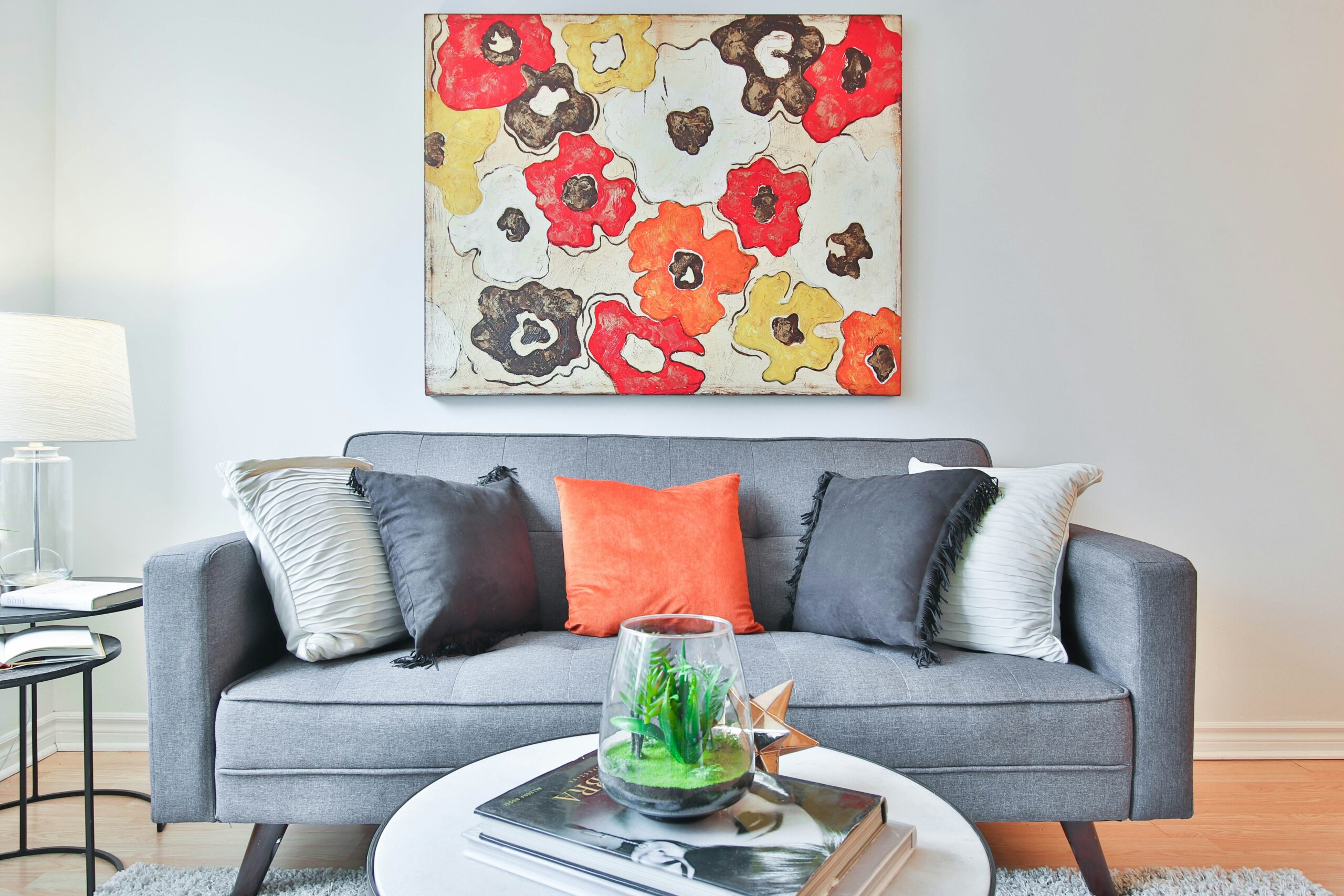
When to Choose a Large Single Piece of Wall Art for Your Space
- You want a bold, impactful, or striking look.
- You prefer a clean, minimal look with one prominent statement piece.
- The wall space is large and uninterrupted, such as above a sofa, bed, or dining table.
- Your room has a modern, minimalist, or contemporary decor style.
Single Piece Size Guidelines:
- Aim for 2/3 to 3/4 the width of the furniture below it.
- For example, if your sofa is 84 inches wide, choose a piece that’s approximately 56 to 63 inches wide.
- Start about 6-12 inches from the top of your furniture.
- Fill about two-thirds of the vertical space to maintain balance without crowding the wall.
- For example: If there are 36 inches of wall space between your sofa and ceiling, consider artwork that is 24–30 inches tall for a balanced look.
- Horizontal art works for low ceilings; vertical art for tall ceilings.
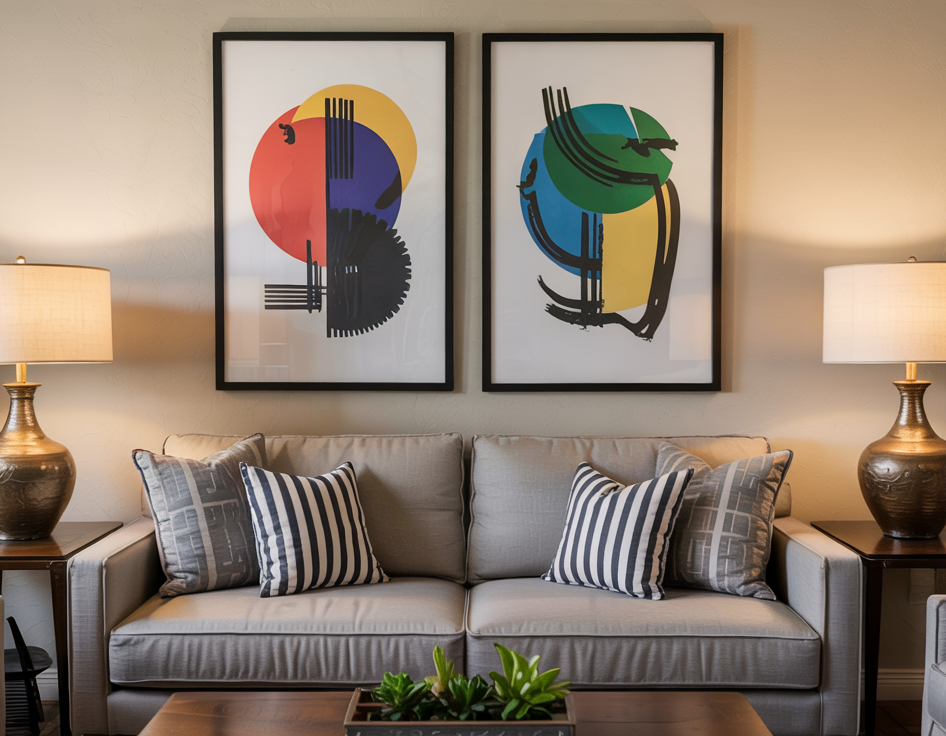
When to Choose a Group of Multiple Pieces for Your Space
- You have several smaller pieces you want to hang.
- You want to display a collection of related pieces of wall art.
- Creating visual interest with a cohesive, balanced look appeals to you.
- The wall space isn’t large enough to accommodate one oversized piece but can handle a few grouped smaller pieces.
- Your decor style leans towards traditional, transitional, or eclectic.
Multiple Piece Size Guidelines:
- Treat the group as one unit.
- Combined width of the group should be about 2/3 to 3/4 the width of the furniture.
- Space pieces about 2–4 inches apart.
- Start 6–12 inches above furniture.
- Same as with a single piece, aim to fill about two-thirds of the vertical space.
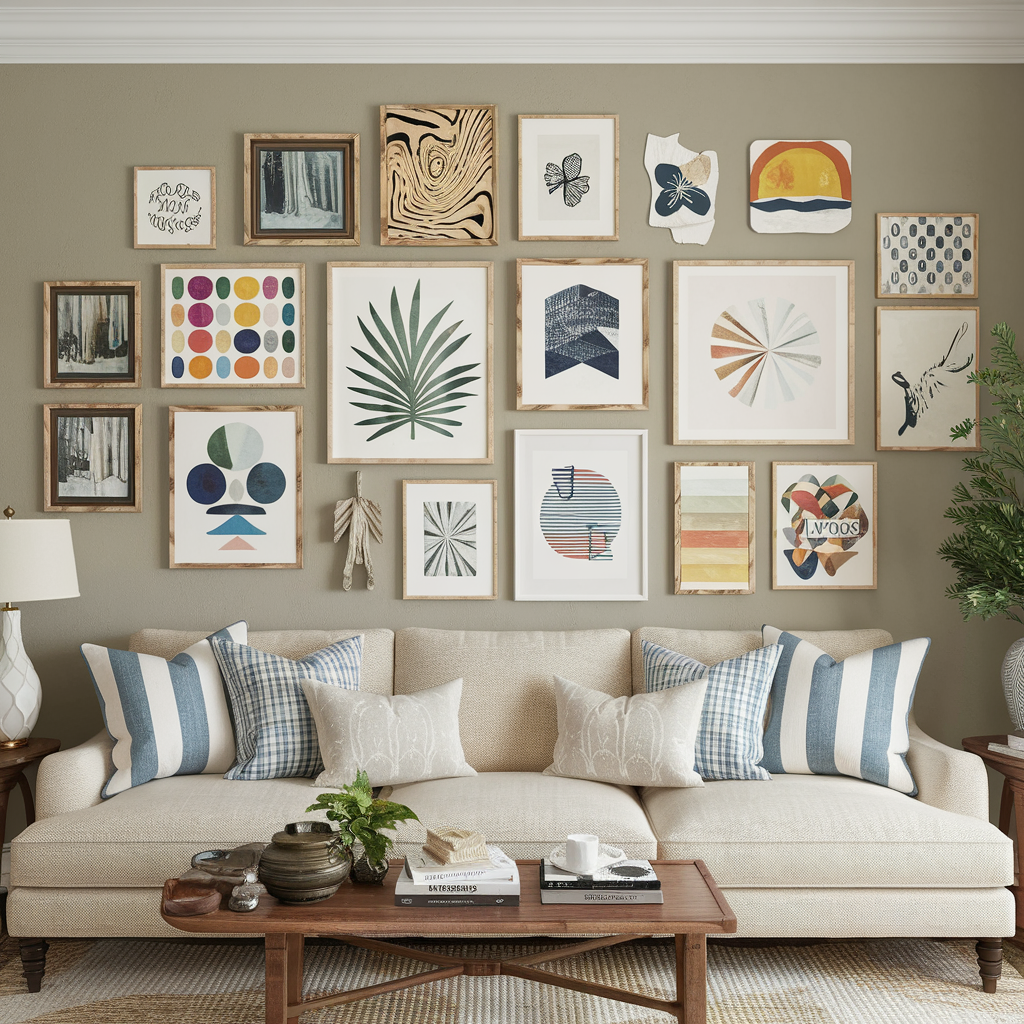
When to Choose a Gallery Wall for Your Space
- You want to showcase a large number of wall art pieces, photographs, or decor items in a range of sizes and styles.
- You love a layered, curated look with lots of personality.
- Your decor style is eclectic, artistic, or traditional; or you want to add a touch of boldness to a modern space.
- Perfect for hallways, staircases, and feature walls
Gallery Wall Size Guidelines:
- No need to stress over size — there is a lot of flexibility with a gallery wall!
- Can accommodate a variety of shapes and sizes. Mix large pieces with smaller accent pieces or stick to a collection of all smaller-sized works.
- Aim to fill at least 2/3 of the wall or furniture width. (Let the size of the wall guide how expansive your arrangement is.)
- Vary spacing for energy and interest or keep spacing uniform for a clean sleek look
- No strict size rules—have fun with it!
And remember, you’re just using these size guidelines to choose the wall art or decor pieces you will be hanging and where you will be hanging them. You’ll see these guidelines again in more detail in the Beginner’s Guide to Hanging Wall Art when you are ready to actually hang your pieces!
Step 4: Choose Wall Art That Fits Your Style
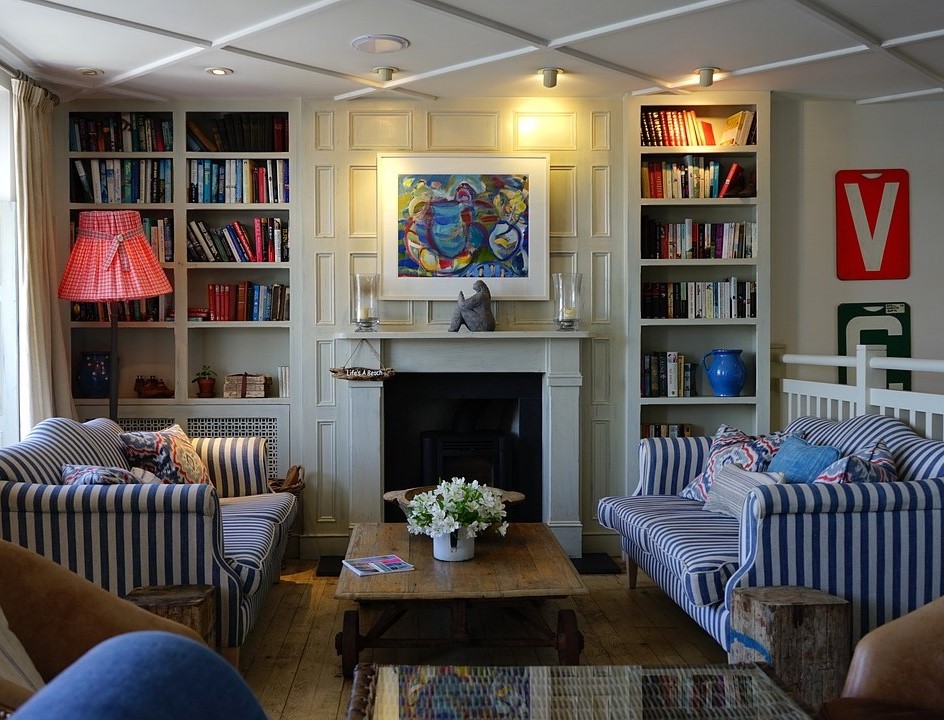
Follow Your Heart—and Your Style
The #1 rule? Choose art you love! Your walls should reflect your personality, not just trends.
That said, selecting wall art that complements your home’s decor style can help create a cohesive look. Not sure what your style is? Start by looking at your furniture, colors, and overall vibe.
How to use the the WHAT’S MY STYLE? chart below:
- Assess Your Room: Look at your furniture, colors, textures, and vibe.
- Match Your Features: Find the category that most closely matches your room’s description.
- Select Wall Art: Use the suggestions to guide your wall art choices.
- Need more help? Visit Beginner’s Guide to Finding Your Decorating Style
| DECOR STYLES | QUICK IDENTIFIERS | WALL ART SUGGESTIONS |
| Classic & Timeless – Traditional – French Country – Mediterranean – Vintage | – Furniture: Rich woods, ornate carvings, traditional forms (e.g., mahogany dining table, clawfoot chairs) – Colors: Warm tones, muted pastels, deep reds, creams – Textures: Upholstered pieces, velvets, florals, intricate details | Oil paintings, botanical prints, romantic landscapes, antique-style maps |
| Rustic & Natural – Farmhouse – Rustic – Modern Farmhouse – Coastal | – Furniture: Weathered wood, natural fibers, relaxed forms (e.g., shiplap walls, wicker chairs, reclaimed wood tables) – Colors: Soft earthy tones, sandy neutrals, beachy blues – Textures: Linen, burlap, textured woods | Nature-inspired prints, seascapes, vintage farm art, driftwood frames |
| Modern & Minimalist – Minimalist – Contemporary – Midcentury Modern – Scandinavian | – Furniture: Clean lines, sleek finishes, light woods (e.g., low-profile sofas, tapered leg chairs, sleek metal accents) – Colors: Neutrals with bold pops (e.g., gray, beige, mustard, teal) – Textures: Smooth woods, glass, metal | Abstract art, black-and-white photography, geometric prints, sleek framed art |
| Artistic & Eclectic – Bohemian – Eclectic – Southwestern – Shabby Chic | – Furniture: Layered textures, vibrant patterns, collected looks (e.g., rattan furniture, colorful throws, macrame wall hangings) – Colors: Jewel tones, earth tones, pops of bright colors – Textures: Woven fabrics, distressed finishes | Macrame, bold abstracts, colorful tapestries, whimsical or handmade art |
| Bold & Luxurious – Art Deco – Western Gothic – Japandi | – Furniture: Statement pieces, rich finishes, dramatic shapes (e.g., velvet sofas, lacquered tables, carved wood accents) – Colors: Jewel tones, black, gold, moody hues – Textures: Mirrored surfaces, metallics, polished woods | Metallic accents, geometric prints, dark or moody art |
Don’t forget to find out even more about your style by visiting the Beginner’s Guide to Finding Your Decorating Style!
Mixing Styles? Go For It!
- Blending different decor styles creates a unique, layered, and personal home.
- Stick with a common thread (color, material, or theme).
- Let one style lead, with accents from others.
- Frame consistency helps tie mixed styles together.
- Don’t overthink—just make it feel intentional.
Next Steps: Ready to Find Your Perfect Wall Art?
Congratulations! You’ve taken the first steps toward transforming your walls into a reflection of your style and personality. You now know:
- What counts as wall art
- How to assess your space
- How to pick the right size
- How to match your style
Now, let’s go find those perfect pieces!
Next Up: Beginner’s Guide to Buying Wall Art

